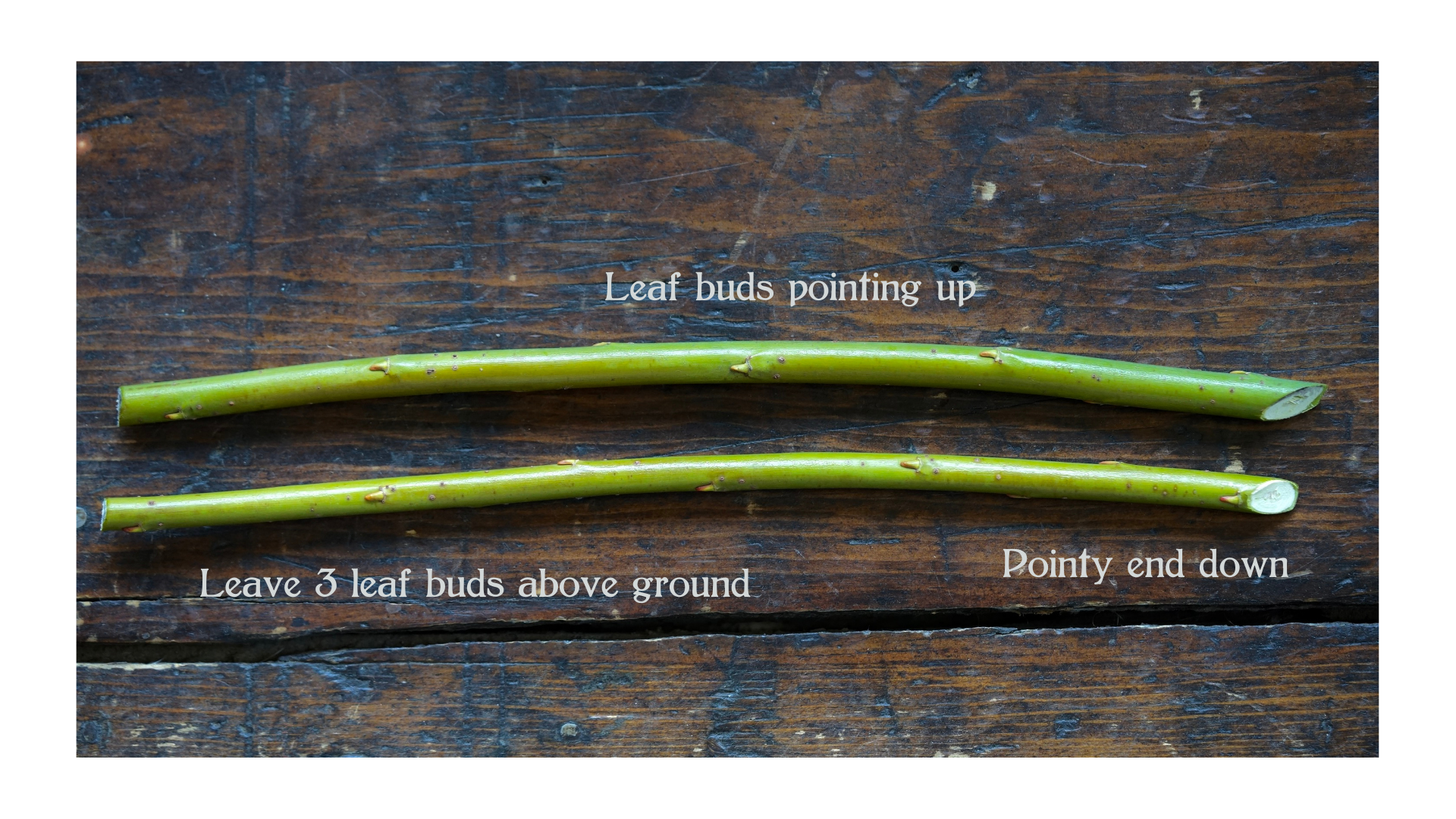WILLOW PLANTING INFO for busy people…
Stick the pointy end in the ground and keep it watered. Don’t let anything eat it. (Seriously, willow really wants to grow! It’s easy!)
WILLOW PLANTING INFO for Type A Personalities…
What makes a good willow cutting to plant?
Ideally a non-woody portion at least 9” in length taken from the bottom 2/3 of a whip. This is done by coppicing the plant, (cutting down to a 1”-3” stub). We sell 12’-14” starts, as we think that gives the best chance for success for our customers. On mature plants, a slightly bark covered cutting may root ok, we sometimes plant these ourselves. Plant your cuttings deeply, leaving only 1/3 of the cutting showing above your soil.
Although the distal 1/3 of a whip,(tip), can be used as a cutting to propagate, it is not ideal, and will take longer to grow into a mature, full plant. With floral varieties, the tips are what you will use for arrangements.
We like to have diagonal cuts on the bottom and squared at the top, which helps placing into the ground and gives more surface area for water uptake in the beginning. It also aids in easily orienting the plant so they are not placed in the ground upside down. (Plant with the pokey end down.)
When should I plant?
Cuttings are best taken during dormancy of the willow in mid to late winter. Cuttings may be held in a cold, dark, damp environment until conditions are favorable for planting, when the ground is no longer frozen and unlikely to do so again that season. Your refrigerator will work, just don’t expose the willow cuttings to the ethylene gasses that fruit produce. We have heard of people storing their cuttings under snow mounds, but have not had the opportunity to try this method!
We do not recommend rooting in water for more than 2 -3 days, but you may start your willow in pots of soil if necessary. Keep them well-watered.
Where should I plant?
Willows like water, so it is best to plant in boggy areas or places that tend to stay moist if possible. They tolerate wet feet, (standing water) for a few months of the year. Although willows can be grown easier than most woody plants, they do not perform well in very heavy clay soils, as they need to send roots out to seek the water they need. This water-seeking habit can lead to problems if planted in the wrong locations, with the roots invading and clogging nearby plumbing and drainage pipes as the roots go for that moisture. Use caution not to plant near swimming pools or septic lines etc.
If your location is not wet, or during dry periods, it is important to water the cuttings generously during the first year! Mulching or weed/landscape fabric helps to retain moisture and keep out weeds that compete for water and nutrients. Although full sun is best, partial shade is tolerated.
WILLOW DOES NOT TOLERATE FULL SHADE, AND PREFERS FULL SUN.
How do I plant?
After your location is chosen and prepped (preferably other vegetation cleared from at least one sq. ft), the cuttings should be prepared. Make a fresh diagonal cut 1/2” from the bottom. It is optimum to place them in water 1/2 way up the stem for a couple of days before planting. You can leave them in water until root buds just barely begin to show, for direct planting into the field, or you can let roots fill out if you are planting into pots, or planting a small enough number that it is feasible to prepare a nice, freshly aerated area. If you plan on sticking the cutting straight into the untilled ground, these longer fragile roots may be damaged. The beauty of willows is that digging with a shovel is not needed! Merely take a rod or stiff stick that is slightly larger diameter than the cutting, ( a piece of 1/2” rebar works great), and push that into the ground about 9-10 inches, give it a little wiggle, remove and then place cutting bottom end first into the hole and leave 2”-3” above ground. If you are using landscape fabric, make a hole just slightly larger than the rod. A good method is to use a jet type lighter to burn a round hole about 1” diameter. This keeps fabric from unraveling and minimizes chances for weeds. Keep soil moist. We like to make sure the hole is filled early on when watering, more so than shallow watering the whole area. Fabric or mulch will reduce moisture loss.
Will willow grow where I live?
Willow typically grows in zones 2-9, which is almost everywhere! If you can provide adequate water and sunlight, you can probably grow willow.







